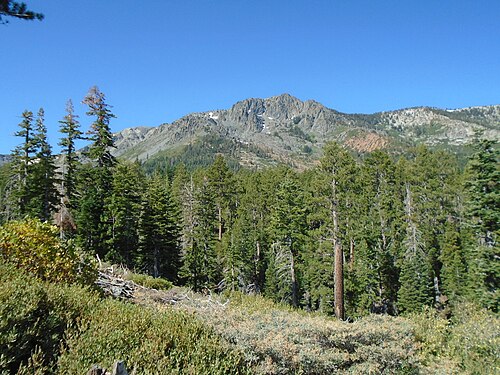Sierra Nevada upper montane forest

The Sierra Nevada upper montane forest is a vegetation type found below the treeline in the United States Sierra Nevada range.[1] It is generally located above the mixed coniferous forest and below the alpine zone.[1] Overstory trees are typically cone shaped to shed the snow.[1]
Characteristic trees including lodgepole pine (Pinus contorta subsp. murrayana ), Jeffrey pine (Pinus jeffreyi), western white pine (Pinus monticola) California red fir (Abies magnifica), and Sierra juniper (Juniperus grandis), and typical understory trees and shrubs such as huckleberry oak (Quercus vaccinifolia) and red heather (Phyllodoce breweri).[1][2]
Environment
On the western slopes of the Sierra Nevada range, upper montane vegetation can be found at elevations from 5,500 to 7,500 feet (1,700 to 2,300 m) in the northern part of the range, 6,500 to 8,000 feet (2,000 to 2,400 m) in the central part, and 8,000 to 10,000 feet (2,400 to 3,000 m) in the southern part.[1] On the eastern slopes, it is at higher elevations. Precipitation in areas of upper montane forest vegetation type is 35 to 65 feet (11 to 20 m), mostly as snowfall.[1] Summer high temperatures range from 73 to 85 °F (23 to 29 °C), and winter lows are below 26 °F (−3 °C).[1] Growing season is about four months because of long-lasting, deep snow.[1]
- Volcanic Ridge from the north, Ansel Adams Wilderness, California
- Mammoth Crest from Sky Meadows (3060m) John Muir Wilderness, California.
- Forest in Placer County, Sierra Nevada, Tahoe National Forest, California.
- Forest in Mount Tallac Trail, Desolation Wilderness, Eldorado National Forest , California.
References
- ^ a b c d e f g h Wiese, Karen (2013). Sierra Nevada Wildflowers: a Field Guide to Common Wildflowers and Shrubs of the Sierra Nevada, including Yosemite, Sequoia, and Kings Canyon National Parks (2nd ed.). Globe Pequot Press. ISBN 0762780347.
- ^ "Forested Communities of the Upper Montane in the Central and Southern Sierra Nevada" (PDF). Retrieved 2024-08-18.




